Making is Thinking
By Andrew Maerkle
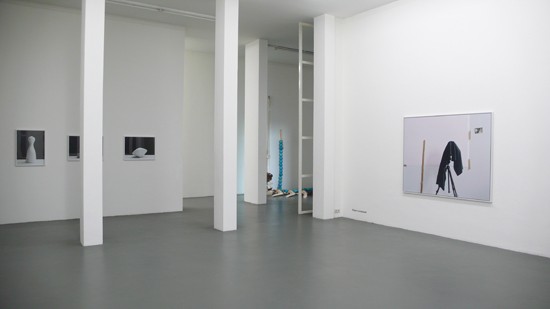
Installation view of the exhibition “Making is Thinking” at Witte de With Center for Contemporary Art, Rotterdam, 2011. Visible at right is the C-print photograph Wand 28.04.2009 (2009) by Edgar Leciejewski; at left black-and-white C-print photographs from Static Dynamic Tension Force Form Counterform (2009) by Ane Hjort Guttu; and in background the mixed-media sculptures The Hairdresser’s Birthday Treat and Cocoa Tourismo (both 2006) by Dewar & Gicquel. All images: Photo ART iT.
Organized by curator Zoë Gray, the recent exhibition “Making is Thinking” at Witte de With Center for Contemporary Art in Rotterdam brought together 12 international artists who synthesize craft and concept. Contextualizing the exhibition against the backdrop of contemporary knowledge industries and the historical dematerialization of labor, Gray selected artists who rethink the world through physical and intuitive processes. Emblematic of this sensibility are works such as Handcrafted Pick-axe and Handcrafted trowels (2003), made collaboratively by Wilfrid Almendra and the duo Dewar & Gicquel, for which the artists painstakingly crafted the titular, commonly mass-produced tools out of wood and steel with their own hands. Similarly, the sculptural installations of Eva Berendes scramble the semantics of object display. For the works included in “Making is Thinking,” Berendes made irregularly-shaped plinth-like constructions out of cardboard and wood – decorated with grid patterns resembling ceramic tiling – that were then used as supports for found ceramic objects. Evoking the erratic contours of Japanese urban architecture and left partially open to reveal their inner structures, the “plinths” competed with the objects for attention, inverting relations of artifice and functionality.
ART iT met with Gray in Rotterdam to discuss the exhibition in greater detail and to ask about her ideas on curating today.
Interview:
ART iT: “Making is Thinking” is the first thematic group show you’ve organized on your own at Witte de With, although you’ve organized solo exhibitions and co-curated other projects. Do you consider this exhibition to be a statement of your position on art right now?
ZG: I would say so. If you’re curating as part of a team then there’s necessarily a mixture between your own interests and those of the institution and its artistic director. Witte de With’s director, Nicolaus Schafhausen, and I have developed a certain thematic line through a particular type of artist’s work that interests us both, but this exhibition explores questions of a more personal preoccupation. With solo shows, there’s a more sustained discussion with the artists, often over the course of a year or more. They tend to take the lead in determining the key themes of the exhibition, and my role is that of an engaged editor. “Making is Thinking” evolved organically out of the artworks that I was encountering over the past couple of years and the conversations I was having, but at a certain point I had to step back and decide my own angle.
ART iT: Why the theme “Making is Thinking”? Where do you see the demarcation between the historical privileging of thinking versus what you identify as an emerging approach to making?
ZG: Philosophically, I’d say the elevation of the rational man and the idealization of the thinker emerged during the Enlightenment. In terms of the distinction between types of work, I would roughly date the division between thinking and making to the Industrial Revolution, through to Henry Ford and his total automation of production in the early 20th century. I think that in art the division has developed over a different time frame, triggered by the Duchampian readymade, which released artists from having to make their own works. I should say that I don’t see it as a negative moment or development in itself, indeed quite the opposite. I’m interested in how conceptual and minimalist art brought different types of industrial making into the art context, a practice that is now so widely accepted as to be almost invisible. Those are three historical moments that underpin the division. And then in recent years, life has become increasingly dematerialized. In my own practice, I’m working with ideas as much as with objects, but the fact is that through digital technology there has been a standardization of the way in which so many of us work, particularly in the developed world, which divorces us from making in a physical sense.
One of the interesting points that Richard Sennett makes in his book, The Craftsman (2008), is that we need to be more skilled in writing our own software, because we are increasingly reduced – even when using open source software – to relying on the tools that other people create for us. We should perhaps be a bit more critical of the standardization of our tools.
I used Sennett’s idea of craftsmanship as the connection between head and hand as a framework for the show, but I wasn’t interested in looking at craft per se. It was more about evoking a mindfulness or awareness of processes of production by bringing together artists who seem interested in regaining control over – or refusing to delegate control of – their making processes. Additionally, I wanted to question how we might make links to different movements in society beyond the artworld that also seem to be about people wanting a deeper connection with the things around them.
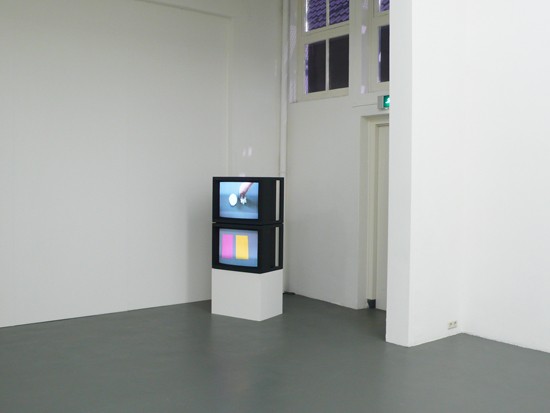
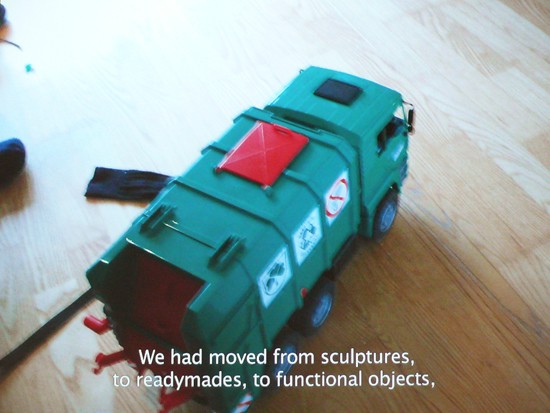
Top: Hedwig Houben – Installation view of Untitled (2010), two videos, 10 min 30 sec each. Bottom: Ane Hjort Guttu – Still from How to Become a Non-Artist (2007), film of 20 stills with voiceover, DVD projection, 12 min.
ART iT: Although the show foregrounds making, many of the artists also engage with strategies of conceptual art, if conceptual art can be loosely understood as looking at the object as you’re making it. You include a number of works that use photography or video to reflect on the making process, like those by Hedwig Houben or Ane Hjort Guttu, and even Eva Rothschild’s large-scale sculpture, SUPERNATURE (2008), with the reflective surface next to it has a similar effect. Were you seeking to emphasize this idea that art doesn’t stop at making, and also involves mediation as well?
ZG: In all of the works there’s a great awareness by the artists of their own making processes. For some that becomes the subject of the work, like in Hjort Guttu’s slideshow How to Become a Non-Artist (2007) and Houben’s videos About The Good and The Bad Sculpture (2009) and Color and Shapes, A Short Explanation (2010), or even Edgar Leciejewski’s “Wands” (Walls) series of photographs shot in his studio. In others, this awareness is present but not central, yet I think all of the artists approach their works with a sense of humor, a wryness that I felt was important.
Alexandre da Cunha’s pieces have this highly aesthetic side to them, for example Green Fountain (2009), which combines a reference to Brancusi’s Endless Column (1918) with a cast coconut and drinking straw, playing with Da Cunha’s own sometimes stereotyped position as a Brazilian artist. His take on how one might reread the Modernist heroes in a Postmodernist way has a real freshness to it that I admire and enjoy.
With Hjort Guttu’s projection piece, I really like the way that she takes her project very seriously while also being keenly aware of the absurdity of using art historical language to analyze the “work” of a four-year-old boy. There is a poignancy to this journey of looking at her own practice through the eyes of her son, but it’s also funny when she says something like, “I suspected he was just doing this to fulfill my expectations,” or “This seemed like a weaker period.”
I think the word “wit” captures rather well the tone of the show. In that way, it also relates to the solo shows I’ve curated here with Saâdane Afif, Cosima von Bonin and Geoffrey Farmer. In all their works, there’s a playfulness and interest in materiality that is also informed by a strong conceptual heritage.
ART iT: What impressed me about Hjort Guttu’s piece is that it didn’t stop at being a gag. The final image with the camera flash reflected in the glass door after the narration’s rhetorical shifting between art, non-art and nothingness had a powerful effect. It throws everything into question, even as it celebrates all the possibilities.
ZG: It reflects upon the fragility of making. When anything is possible, what do you do? When anything can be art, how do you know as an artist that what you’re doing has enough value for you – not even for fulfilling other people’s expectations of art, but for yourself? I think Hjort Guttu’s work and Hedwig Houben’s videos tap into this struggle about why we make and how we make and what it means to be an artist.
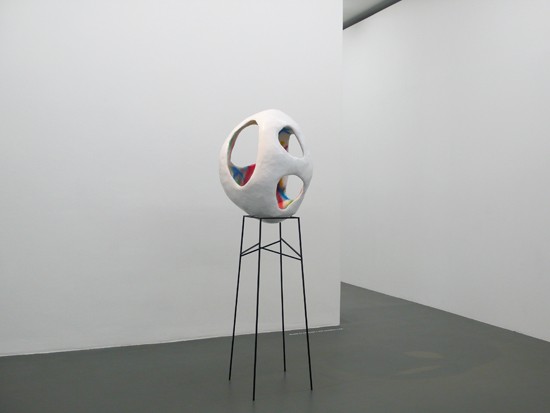
Eva Rothschild – Installation view of Yr Inner Child (2009), fabric, wire, jesmonite, fiberglass, hardboard, paint, powder-coated steel, 223 x 61 x 58cm. Collection Ken and Helen Rowe, London.
ART iT: You include artists from a broad geographic spread, such as Teppei Kaneuji and Koki Tanaka from Japan. I’m interested in how the collapse of geographic boundaries in recent years has brought together so many different voices in a shared but undefined space, and how curators respond to that. When you travel overseas, how do you balance context and intuition in evaluating works?
ZG: It’s hard to say because some works communicate so strongly and directly that they shatter any contextual limitations – or limitations of my understanding of the context behind them. With others, you need more contextual information in order to understand why the work is interesting (or not!).
However, “Making is Thinking” is not a survey show. I think context becomes more of an issue as soon as you start applying national labels. Then perhaps you have more of a “moral” obligation to show things that maybe you’re not so interested in. It’s also about access to information. We have this idea that now that we supposedly can know everything, we should know everything.
I think this relates to a concurrent boom in research-based practice and a “residency culture”: a focus on work that explains itself, where sometimes the explanation is more interesting than the finished thing. A significant number of artists can’t really find money to think and to produce unless either they have a commercial gallery putting up the money – which happens less and less – or they’re doing a residency. In the latter case, they may have money to produce a work in a particular context, but must also negotiate the expectations that come with that context. It’s now possible to recognize a style of artwork that is clearly “residency work,” and sometimes when you review an artist’s practice you see how it’s fragmented by these different research projects. You wonder: what’s the connecting thread?
For this exhibition, I was drawn to works that have a certain formal resolution to them, but are also irritating enough to be interesting. Eva Rothschild’s work is particularly significant in that respect because it defies analysis in a way. It’s sculptural and falls into a lineage of what I would call British sculpture, or a certain European Modernist sculpture – you could tease out the references and describe the material and the feelings created – but it still resists being pinned down.
ART iT: Can you talk about what it means to curate at Witte de With? Do you think there is an institutional ethos towards exhibition making?
ZG: I think there is, but it changes with each director. We have had five artistic directors in 21 years. And because we don’t have a collection, because we’re a relatively young institution and because from the beginning there was this stipulation that each director could stay for only six years maximum, there is a sort of structured flexibility to the institution. It has always been quite an authored program, with noticeable changes between the different directors. Chris Dercon was the first director (1990-95) and his successor Bartomeu Marí maintained certain precedents but also developed his own approach (1996-2001). Then Catherine David, who was here for the shortest period (2002-04), turned the focus onto research and publications, with exhibitions that were often essayistic and text heavy.
After an interim directorship, David was followed by Nicolaus Schafhausen, who brought me into the institution. I think one of the reasons he was appointed was because he had built a reputation for creating exhibitions that were very much about the experience of works of art. He has organized a number of shows here that have been quite theatrical. For example, “Don Quijote” (2006) and “Street: behind the cliché” (2006) – both group shows – toyed with experience culture. They had theatrical lighting and were strongly curated, in that certain works were only visible at certain times, so you had to wait until a video was finished before the painting next to it was illuminated, and so on.
We try to create a program that is politically aware without being politically correct, by showing works that relate to things beyond themselves but that are not illustrative of overly specific thematics. For example, the first show that Schafhausen and I curated together, a solo show of Brian Jungen (2006), featured an artist who at that time was working with issues of cultural hybridity in a Northwest Canadian context, work that we thought would be relevant in relation to local debates about multi-cultural society and national identity. Or in 2009-10 the exhibition program adopted the leitmotif “morality” for a year and considered it through different themes and questions. This was very much connected to the political situation in the Netherlands and Western Europe, and the increasing polarization of political life here. However, the works in the show were not necessarily about that. So there are certain archetypal Witte de With approaches, but they will surely change again under the next director.
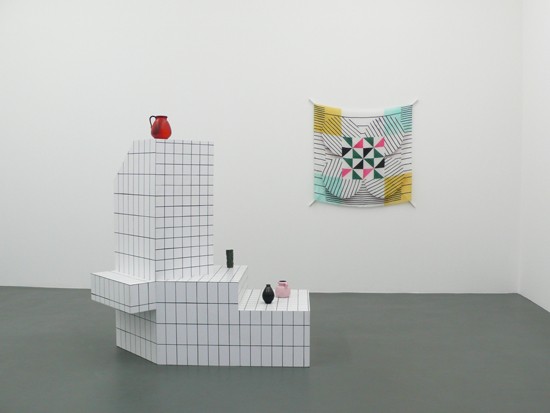
Eva Berendes – Installation view of Untitled (Counter) (2009, foreground), cardboard, lacquer, wood, four found ceramic objects, 130 x 150 x 80cm; and Untitled (Silk hangings) (2009, background), silk, silk paint, metal, lacquer, magnets, 121 x 121cm installed.
ART iT: Finally, as you transition from emerging to experienced curator, what are some of the issues that you anticipate for the future of curatorial practice?
ZG: There are major challenges that are already present and will only grow more extreme, as debates intensify about the role that culture can or should play in society. All of us who work in contemporary art will have to find clever ways to survive and to keep challenging people to think. There is an increasingly prevalent and, I find, misguided view of culture as a form of entertainment that should only reaffirm the status quo, with less space and less money available for difficult work and difficult exhibitions. In political policy there seems to be a shortsighted tendency to underestimate this amorphous group called “the public” who are portrayed as being quite stupid and who apparently want to see only stupid things. Culture can be difficult and still be accessible. It doesn’t have to be divided between categories of elitist versus populist, or entertaining versus brain-crunchingly painful. I find that I’m interested in things I don’t understand, and I’m sure I’m not the only person to feel that way.
Then I think there’s the question of how we can deal with the experience of art in today’s highly mediatized cultural environment. How do you create moments for contemplation, for looking, for thinking? I’m curious to see how technological advances will impact exhibition practice. I’m quite cynical about these increasingly prevalent mediation tools, where you are encouraged to visit a show with your smartphone in hand so you can get all this additional information, because that can also create distance rather than proximity. I think it’s necessary to assert the importance of the white cube – even if it’s a flawed and problematic space – just so there can be some sort of alternative time frame, rhythm and space for thinking.
“Making is Thinking” was on view at Witte de With Center for Contemporary Art from January 23 to May 1, 2011. For more information, see here.
Zoë Gray (UK) is a curator at Witte de With, where she was worked since early 2006. In Rotterdam, her recent exhibitions include Cosima von Bonin (2010), Billy Apple (2009) and Saâdane Afif (2008). Outside of Witte de With, her curatorial projects include Cyprien Gaillard’s “Beton Belvédère” (Stroom, The Hague, 2009) and “Manufacture” (Parc Saint Leger, Pougues-les-Eaux, 2011). She is vice president of IKT (International association of curators of contemporary art).
